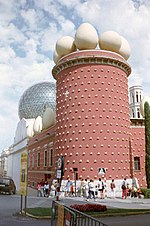Artist museum
As artists Museum lasted until the 1960s only a museum, a late-forming artist dedicated and whose oeuvre. Today, the museums conceived or realized by artists as works of art are also referred to as artists' museums.
Dedicated museums
The famous forerunners of the museums dedicated to an artist include the Gipsoteca Canoviana in Possagno, which has existed as a museum since 1836 , the first Schinkel Museum opened in Berlin in 1844 on the initiative of Friedrich Wilhelm IV , and the one from the donation of the sculptor Ludwig Schwanthaler to the Royal Academy of the fine arts in Munich, created in 1848 by the Schwanthaler Museum (cf.).
Municipalities and cities sometimes posthumously set up a museum for a famous artist in the city , such as Bern's Paul Klee Museum or Bremen's Paula Modersohn-Becker Museum . Usually set up in a previous place of activity, such as a studio or home, such artist museums are usually managed by a foundation .
Museums designed as works of art
Marcel Duchamp implemented the concept for a museum as a work of art in his Boîte-en-Valise ( box in a suitcase ) in 1941 , but had already dealt with the museum as an institution in 1920 and, together with Katherine Dreier , the ” Sociéte Anonyme, Inc. , Museum of Modern Art ”, founded with himself as President.
Many artists later conceived museum projects as works of art, initiated in the late 1960s by criticism of the bourgeois concept of art and existing museum institutions. A feature of such artist museums is often “that the exhibition design itself represents a conceptual artistic work.” In some cases, such conceptual artistic works were realized as collections and museums with unusual content and alternative classification criteria. In 1970 Werner Haftmann spoke of the "anti-museum". Art museums became generally known in the art world as one of the themes of Documenta 5, Kassel 1972 and through individual museum projects such as Marcel Broodthaer's Eagle Museum, Claes Oldenburg's Mouse Museum and Daniel Spoerri's Musée Sentimental . Some artists took up the form of the conventional artist museum again in order to create a museum for their own work during their lifetime. Examples are the Museo Vostell Malpartida and Wolf Kahlen Museum as well as the Teatre-Museu Dalí .
See also
Individual evidence
- ^ Rudolph Marggraff: The Schwanthaler Museum in Munich. In: Munich Digitization Center Digital Library. Bayrische Staatsbibliothek, p. 5 , accessed on October 4, 2011 .
- ↑ Christine Hoh-Slodczyk: The house of the artist in the 19th century . Prestel, 1985, ISBN 3-7913-0734-7 , pp. 42 .
- ↑ Astrid Legge, p. 57.2, p. 59.3, p. 61.2f.
- ^ Tobias Wall: The Impossible Museum: On the relationship between art and contemporary art museums. 2006, p. 234, footnote 86 , accessed October 4, 2011 .
- ^ Astrid Legge: Museums of a different "kind". Dissertation . Philosophical Faculty of the Rheinisch-Westfälische Technische Hochschule Aachen, 2000, p. 12,2, p. 117,2, p. 113,6ff quote from Wieland Schmied “... new forms of visual communication beyond the traditional art concept of the completed work would have to be achieved , [...] in the sense of a new, expanded concept of art as an ongoing, incomplete [...] process in which the viewer is included. "
- ^ Werner Haftmann: The Museum in the Present. In: Gerhard Bott (Ed.): The Museum of the Future, 43 contributions to the discussion about the future of the museum. Publisher M. DuMont Schauberg, Cologne 1970, p. 112.
- ↑ See exhibition catalog documenta 5, Kassel 1972, there “Museums of Artists”

